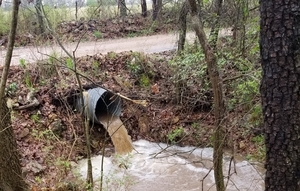Save the Illinois River, Inc. | Environment | May 19, 2023

Stormwater runoff in the Illinois River watershed after a heavy rain, STIR PhotoFrom the Tahlequah Daily Press by D.E. SmootSTAKEHOLDER STEPS: Arkansas, Oklahoma collaborate to draft Watershed Management Plan for Illinois River Basin WEST SILOAM SPRINGS — Illinois River stakeholders rolled up their sleeves, staking out a wide variety of interests they hope will be addressed in a watershed management plan for a drainage basin that saddles portions of two states.
About 100 people turned out for the second of what is expected to be four meetings coordinated by the Arkansas Natural Resources Commission and Oklahoma Conservation Commission — the largest gathering to date. Following a brief introduction and overview of the joint project, stakeholders split into groups to weigh in on rural and urban issues that impact the ecological health of the Illinois River basin and water quality.
The Illinois River, a nutrient-limited stream protected by Oklahoma’s Scenic Rivers Act, flows from northwest Arkansas into northeast Oklahoma. It is impounded by Tenkiller Lake Dam before it flows into the Arkansas River, which winds southeastward across Arkansas and empties eventually into the Mississippi River.
Organizers said the “nonregulatory plans” forged from what has been described as a historic two-state collaboration will address ways to reduce nonpoint source pollution. The management plans also will address ways to mitigate the impact of rapid urbanization in the upper reaches of the basin.
Officials on both sides of the state line hope to accomplish those goals by establishing a framework for sustainable water management practices. That framework is expected to include pollution-reduction strategies that aim to preserve the basin’s ecological integrity.
Some concerns expressed by rural stakeholders included phosphorus pollution that can be attributed to the nutrient-rich waste produced by the poultry industry. Related to that topic were barriers to the efficient removal and disposal of poultry litter: transportation costs and the need for greater transparency of application sites were chief among those concerns.
Other rural concerns included streambank erosion, which leads to a loss of land to flooding or changes in how it can be used. There also was discussion about the need for more riparian buffers, wetland protection, and how to address the multigenerational impacts of conservation easements.
Those easements, which are secured most often by payments to landowners who promise to protect parcels from development and production, also were addressed by urban stakeholders. Other urban concerns included green scaping and improved management and protection of floodplains.
While topics that came up Wednesday had a familiar ring to many who have battled for decades to protect and preserve the scenic river, some saw a glimmer of hope.
“At least they are talking more about what isn’t working and a greater need for floodplain management,” said Ed Brocksmith, treasurer and co-founder of Save the Illinois River Inc. “They also recognized the need to educate the public … about a changing climate that will have a huge impact on our watershed.”
As an example, Brocksmith cited the need for urban planners to design for a “warmer and wetter” climate. That fact was included in the findings of a basin-wide flood study completed recently by the U.S. Army Corps of Engineers.
“We know we are going to be wetter and warmer in the years ahead,” Brocksmith said. “Are we doing more to design stormwater drainage systems that can handle all that water? Are we doing more to mitigate the erosion caused by all that water?”
Barb Daily, a STIR board member, said she is hopeful about the eventual outcome of the planning process even though many issues discussed this week have been debated and studied for decades.
“It gives me hope in one way that one of the first slides shown in the other room was about building partnerships,” Daily said, citing past problems that stem from a lack of transparency. “Too many times, especially governmental operations, hold on to information …, but I know people are working together and it’s great to see so many different people here today.”
Tate Wentz, water quality division manager for Arkansas Natural Resources Commission, said he expects the third stakeholders meeting will convene in August.
That meeting will focus on soil and water assessment tool being used to model the watershed and determine best management practices going forward.
A fourth meeting expected to take place in October will summarize the information gleaned from stakeholder meetings and agency efforts to draft the final plans.
